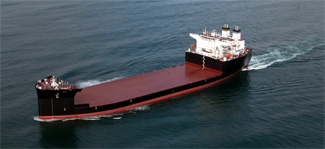While the U.S. petroleum boom holds the promise of greater gains on the commercial side for American shipbuilders, the outlook isn’t as bright for military orders. Congressional gridlock and the threat of more Pentagon budget cuts have added uncertainty to a sector increasingly vulnerable since the recession.
A number of programs continue to move forward, however, and there were some notable deliveries during the past year. Among them were USNS John Glenn, the second mobile landing platform (MLP) built by General Dynamics NASSCO for the U.S. Navy’s Military Sealift Command, and USNS Millinocket, the third of 10 Spearhead-class joint high speed vessels (JHSVs) delivered by Austal USA. Ingalls Shipbuilding delivered the national security cutter Hamilton to the U.S. Coast Guard and completed the amphibious assault ship America for the Navy.
Another positive development involved the U.S. Coast Guard’s new offshore patrol cutter (OPC). Bollinger Shipyards, Eastern Shipbuilding Group and Bath Iron Works each received a $21.9 million design contract for the project, which will result in 25 ships being built at a cost of $10.5 billion — the Coast Guard’s biggest acquisition ever.
The awards came despite protests from Huntington Ingalls and VT Halter Marine, whose design bids weren’t accepted. The two shipbuilders disputed numerous points in the Coast Guard’s selection process, but the Government Accountability Office (GAO) rejected their arguments.
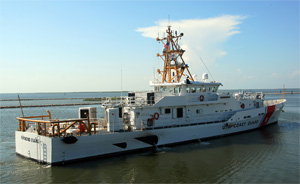 |
|
USCGC Raymond Evans is one of two fast response cutters that Bollinger Shipyards delivered to the Coast Guard. |
|
Courtesy Bollinger Shipyards |
The construction contract will be awarded to Bollinger, Eastern or BIW in 2016. The ships will replace the 210-foot and 270-foot medium endurance cutters used to conduct security operations, search-and-rescue missions and drug interdictions. The Coast Guard expects the first steel to be cut in fiscal 2018.
Other big-ticket items for the Coast Guard include a proposed $1 billion polar icebreaker and spending $100 million to reactivate the icebreaker Polar Sea until the newbuild gets the go-ahead. Polar Star is currently the only heavy icebreaker on duty for the USCG.
The Coast Guard’s plans may run into harsh budget realities in Washington, a scenario that Vice Adm. Charles Michel warned against during a June hearing of the House Subcommittee on Coast Guard and Maritime Transportation. According to current budget blueprints, annual funding for Coast Guard acquisitions won’t exceed $1.2 billion for the next five fiscal years. That is about $1 billion less per year than the GAO and the Coast Guard say is needed to keep programs on schedule and on budget.
“I have seen the devastating impacts when vessels are unreliable, obsolete or outclassed by adversaries or the sea itself,” said Michel, deputy commandant for operations.
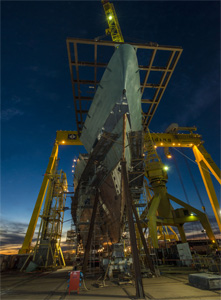 |
|
USCGC James, shown under construction at Ingalls Shipbuilding in Pascagoula, Miss. |
|
Courtesy Huntington Ingalls |
Matt Paxton, president of the Shipbuilders Council of America, said the possibility of further cuts through sequestration — for both the Navy and Coast Guard — is exacerbated by the fact that the federal government is operating on a continuing-resolution basis.
“That’s not the best way to manage these contracts,” Paxton said. “These contracts do better when they have predictability and long lead times. … (Shipbuilders) get their schedules down, they get their materials down, and they get efficiencies throughout the shipyard. What goes into that is the certainty of having a budget that’s going to be in place.”
Here is a look at other military-related activity at U.S. shipyards in the past year:
Bollinger Shipyards
The Lockport, La.-based company delivered the fast response cutters Kathleen Moore and Raymond Evans to the Coast Guard, the ninth and 10th FRCs in the series. The yard also received a $255 million option to build six more of the Sentinel-class ships, bringing the number to 30 FRCs under contract with Bollinger. The package is valued at $1.4 billion.
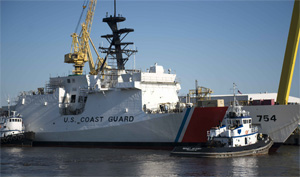 |
|
USCGC James is the fifth national security cutter launched by Ingalls Shipbuilding. |
|
Courtesy Huntington Ingalls |
Austal USA
Austal has delivered three JHSVs to the Navy as part of a 10-ship, $1.6 billion contract. The third in the series, USNS Millinocket, will be followed by Fall River (delivery in late 2014), Trenton (September launch) and Brunswick (under construction).
The Mobile, Ala., shipbuilder also launched USS Montgomery, the second of 10 littoral combat ships (LCS) the company will produce for the Navy in a $3.5 billion deal. Five more of the Independence-variant ships are under construction: Jackson was christened in March, Gabrielle Giffords was scheduled to be launched later in 2014, and work was underway on Omaha, Manchester and Tulsa.
Bath Iron Works
The Navy awarded the Maine shipbuilder a $100 million contract to provide planning yard services for the LCS program. BIW is a business unit of General Dynamics.
The deal covers both LCS variants, the Freedom class and Independence class. BIW will provide ship alteration design and logistics support, material support and maintenance. BIW is also the planning yard for the Navy’s DDG 51 destroyers and FFG 7 frigates.
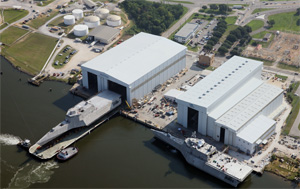 |
|
The littoral combat ship USS Montgomery, bottom, is guided out of dry dock in August at Austal USA in Mobile, Ala. |
|
Courtesy Huntington Ingalls |
Huntington Ingalls
Pascagoula, Miss.-based Ingalls Shipbuilding delivered its fourth national security cutter, Hamilton, to the Coast Guard in mid-September. The fifth NSC, James, is scheduled for delivery in 2015. The keel laying for the sixth, Munro, was scheduled for fall of 2014. Kimball is under production and long lead-time materials for the eighth, Midgett, have been ordered.
In March, Huntington Ingalls’ Newport News Division received a $1.2 billion extension on a construction preparation contract for the aircraft carrier John F. Kennedy. The extension enables the Virginia yard to complete an additional 343 structural units and purchase the majority of the remaining material for the ship.
Marinette Marine
The Navy awarded a $698 million contract in March to build two more littoral combat ships at the Wisconsin shipyard. LCS 17 (the future USS Indianapolis) and LCS 19 are the seventh and eighth of a 10-ship contract originally awarded to project partner Lockheed Martin in 2010. The first of those ships, USS Milwaukee (LCS 5), is scheduled to be delivered in 2015.

